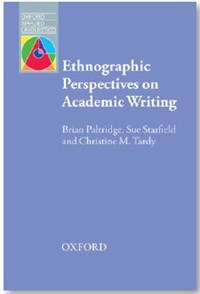Ethnographic Perspectives on Academic Writing
Brian Paltridge, Sue Starfield and Christine M. Tardy
Oxford University Press 2016

Research methods books present a bewildering and occasionally hostile landscape of methods, methodologies, ontologies and epistemologies, many of which do not seem suitable for the small territory of academic writing. Ethnographic Perspectives on Academic Writing leads the academic writing researcher through the EAP landscape using one orientation device: ethnography.
Reader-friendly from the start, the Preface introduces the authors by their first names and allows them to explain how they became ethnographic researchers. As their respective routes into the field were very different, any fears that the book may be too dry and technical are allayed. Prefaces of linguistics books tend to be either content-free (‘I’d like to thank ...’ with a huge list of acknowledgements) or heavily theoretical (‘The methodology of this book is based on ...’), so this is a clever ploy: the three stories make you want to read on. In an equally encouraging manner, the introduction to the book is a model of clarity and brevity, providing brief overviews of every chapter.
The authors’ aim is ‘to provide a state-of- the-art account of ethnographically oriented second language writing research in the area of English for academic purposes (EAP) research’, with a specific focus on ‘writers’ experiences, writing practices, and the contexts in which academic texts are produced and assessed’. It is divided into eight chapters, all worthy of attention, saving us hours of library searching and even more hours of reading.
Chapter 1, What is Ethnography?, shows how ethnography has developed since the pioneering work of anthropologist Bronisław Malinowski in the 1920s. The authors admit that ‘ethnography is a broad and contested field’, and is therefore hard to define. Definitions are nevertheless given and explored, and we come to understand that ethnography most often involves a combination of participant observation and in-depth interviewing, collecting data from a range of sources. Ethnographically-oriented research tends to be small-scale and long-term. This makes it highly suitable for Ed or PhD research into academic writing practices, though perhaps less suitable for one-year taught Masters courses.
Very importantly, this first chapter points out that in contemporary ethnography the researcher’s position is acknowledged to be subjective, and that this needs to be dealt with as part of the methodology and findings. For practitioner-researchers who are positioned awkwardly between the people they are researching and the institution in which they work, this is a valuable insight. No longer observing students with a cold scientific eye, researchers can use ‘the ethnographic gaze’ to demonstrate the ways in which academic writing forms part of a social context in which the researcher too is present. Writing ethnographically allows the researcher to employ a more ‘personal voice’ which ‘organizes and shapes the text’, while ‘disclosing to the reader the “backstory” of the fieldwork experience’. This is all very encouraging.
Chapters 2 and 3, Context and Academic Writing Research and Ethnographic Perspectives on Academic Writing Research, describe the ways in which ethnographic perspectives have filtered into sociolinguistics, pragmatics, systemic functional linguistics and academic literacies research, all of which have dealt with academic writing in different ways. These are crucial chapters and I now feel I have a much better understanding of the ways in which different schools of thought have investigated EAP.
The central part of the book (Chs 4–6) deals with ethnographic perspectives on academic writing in three specific domains: undergraduate, postgraduate and research writing. Each chapter uses examples of fruitful research areas as well as summaries of published studies. The chapter on postgraduate writing (Ch 5), for example, includes a section on research into dissertation and thesis writing: useful for EAP teachers as well as for academic writing researchers. There is a certain amount of overlap between these three central chapters, and some studies are mentioned several times, but my feeling is that this deepens the reader’s understanding of the most significant pieces of research. A researcher would probably come across most of these ethnographically-oriented studies at some point, but it is incredibly helpful to have them so succinctly summarised and contextualised within a single volume.
Chapter 7, Ethnographic perspectives on Learning and Teaching Academic Writing, is the most practitioner-focused chapter. It is in this area, the authors suggest, that ethnographic perspectives can be particularly valuable, as they ‘give insight into [writing] development as an individual and contextualised process’, unlike studies which attempt to chart a writer’s development through changes in linguistic features of the texts they produce. As the authors point out, ‘development is not traceable solely through texts’. Ethnographic forms of inquiry allow us to see the student’s level of scholarly/writerly identity and disciplinary knowledge as well as the inside story of the contexts within which texts are produced and put up for assessment. These advantages are re-iterated in the Conclusion, by which point I had decided that ethnography is the perspective I wish to adopt in my own research!
If you are new to research and wish to investigate academic writing, this book is a must-read. I plan to go through it one more time from cover to cover before I embark on the first major draft of my thesis.
Terri Edwards has been working in ELT since 1986. She has worked in Germany and Japan as well as the UK, and is currently teaching EAP at Durham University.
Comments
Write a Comment
Comment Submitted